Overview
This article serves as a comprehensive guide on connecting SharePoint lists to Power BI. It outlines the prerequisites, provides a step-by-step process, offers troubleshooting tips, and highlights the benefits of this integration. By following the outlined steps and grasping the advantages—such as improved information analysis and enhanced decision-making—organizations can effectively leverage this integration. This not only boosts operational efficiency but also fosters a collaborative environment. Take action now to transform your data handling and decision-making processes.
Introduction
In the modern business landscape, effectively harnessing data can differentiate success from stagnation. Power BI and SharePoint—two robust tools from Microsoft—when integrated, create a dynamic synergy that allows organizations to visualize and share insights seamlessly. This integration not only enhances data accessibility but also fosters collaboration and informed decision-making across teams. Given the increasing demand for real-time data and actionable insights, understanding how to connect SharePoint lists to Power BI is essential for organizations aiming to cultivate a strong data culture.
From troubleshooting connection issues to leveraging advanced features, this article explores the intricacies of maximizing the potential of Power BI and SharePoint integration, ultimately transforming data into a strategic asset.
Understanding Power BI and SharePoint Integration
This tool distinguishes itself as a robust business analytics application, enabling users to visualize information and share insights across their organizations. In contrast, the platform operates as a web-based collaboration tool seamlessly integrated with Microsoft Office. When these two powerful tools merge, the software retrieves information from a SharePoint list to Power BI, facilitating the generation of dynamic reports and dashboards that represent real-time insights.
The integration of the SharePoint list to Power BI significantly enhances information accessibility and fosters improved collaboration and decision-making processes within organizations.
Key Benefits of Integration:
- Enhanced Information Visualization: The tool effectively transforms raw data from a collaborative platform into interactive dashboards, simplifying complex datasets for easier understanding and analysis.
- Real-Time Insights: Users gain access to up-to-date information, which is crucial for timely decision-making, particularly in fast-paced business environments.
- Improved Collaboration: Teams can share reports directly within the platform, promoting a collaborative atmosphere that boosts productivity and engagement.
Creatum GmbH’s services, including the innovative 3-Day Sprint and the General Management App, offer a streamlined approach to report creation, ensuring that organizations can quickly develop professionally designed reports tailored to their specific needs. This service not only accelerates the reporting process but also addresses information inconsistency and governance challenges, ultimately enhancing decision-making capabilities.
Recent statistics reveal that fewer than 20% of executives believe they have established a ‘culture of information’ within their organizations. This underscores the importance of effective information integration tools such as BI, which can assist organizations in cultivating a stronger information culture by making insights more accessible and actionable. Moreover, starting in 2024, the need for accessible analytics solutions becomes even more pressing, enabling non-technical users to extract insights from data.
The combination of Power BI and an alternative platform meets this requirement by streamlining information analysis and reporting.
Real-life examples demonstrate how organizations leveraging this tool alongside an alternative platform have significantly improved their operational efficiency. For instance, companies utilizing this integration have reported enhanced decision-making capabilities and streamlined workflows, ultimately driving growth and innovation. A testimonial from Sascha Rudloff, Team Leader of IT and Process Management at PALFINGER Tail Lifts GMBH, highlights the transformative impact of Creatum’s Business Intelligence Sprint, stating that it not only provided an instantly usable Business Intelligence report but also significantly accelerated their own Business Intelligence development.
As the business intelligence landscape evolves, with Mode Analytics leading with a 27.78% market share, the combination of BI tools and collaboration platforms continues to offer strategic advantages for organizations aiming to leverage the full potential of their data.
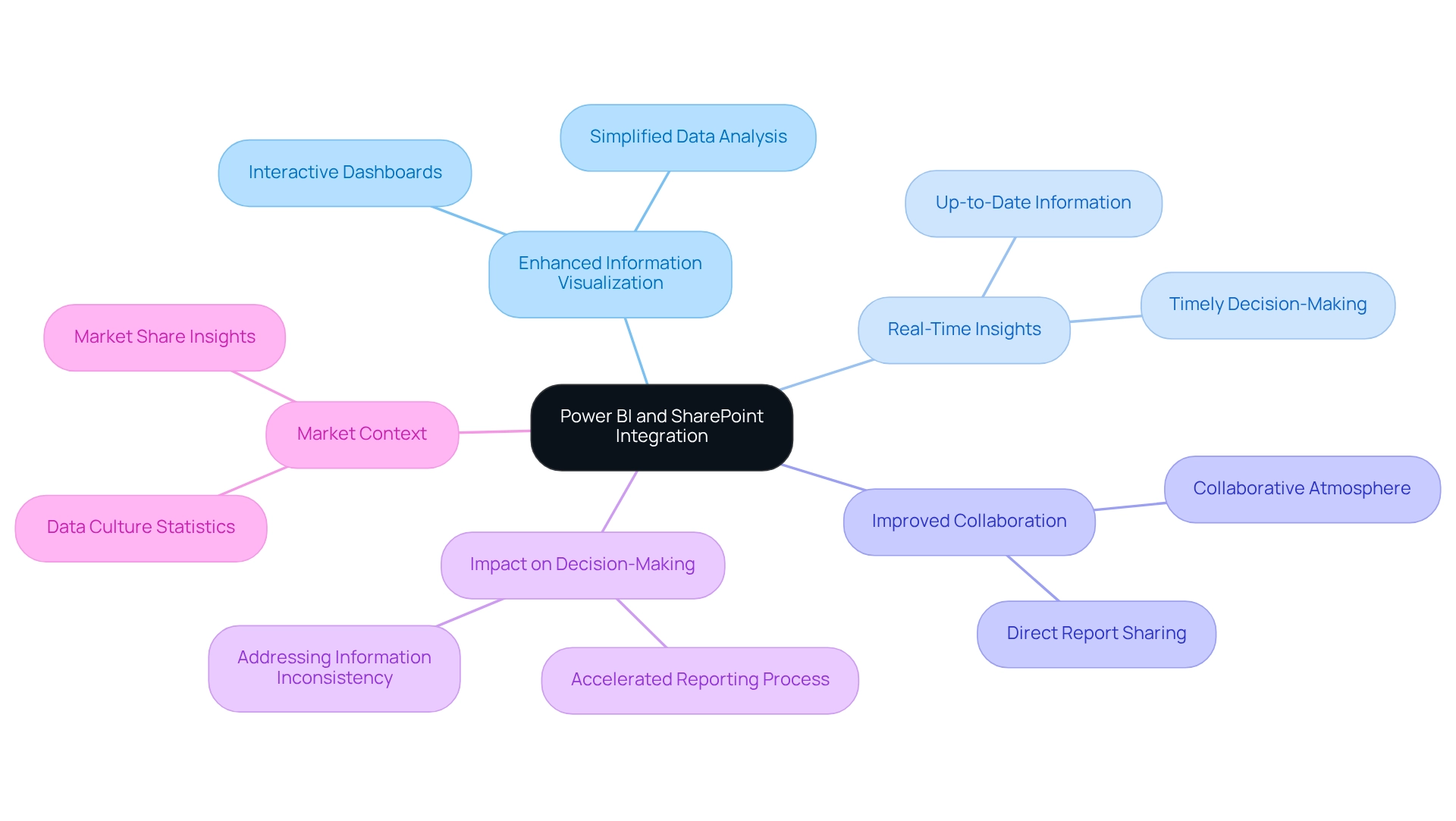
Prerequisites for Connecting SharePoint Lists to Power BI
To effectively link lists from a collaboration platform to Business Intelligence and leverage its full capabilities, it is essential to meet the following prerequisites:
-
Access to Power BI Desktop: Start by downloading and installing Power BI Desktop from the official Microsoft website. This tool is vital for creating and managing your reports, enabling you to extract actionable insights that drive operational efficiency.
-
SharePoint Online Account: Ensure you have a valid SharePoint Online account with the necessary permissions to access the specific lists you intend to connect. User permissions are critical for information accessibility and security. As Annika Baumhecker, a Market Research Analyst, highlights, efficient information management and analytics are crucial for utilizing tools like BI, especially in environments where RPA can automate manual workflows, enhance productivity, and minimize errors, allowing your team to focus on strategic, value-enhancing tasks. To connect your SharePoint list to Power BI, obtain the URL of the site containing your desired list. This URL is essential for creating a successful link that integrates the SharePoint list into Power BI, facilitating smooth information integration.
-
Information Permissions: Verify that you have the appropriate permissions to view and obtain the information within the SharePoint list. Correct permissions are vital to ensure users can effectively utilize analytics tools without facing access issues. Given that the organization is currently achieving a maturity level of 200 in executive sponsorship, enhancing information integration efforts through RPA is crucial for boosting operational efficiency and advancing strategic objectives.
-
Internet Connection: A stable internet connection is necessary to connect to SharePoint Online, ensuring seamless information retrieval and report generation.
By adhering to these prerequisites, organizations can enhance their information integration efforts. Additionally, regular adoption monitoring, as illustrated in the case study on the benefits of adoption tracking, can foster improved resource allocation and strengthen executive support for projects. This ongoing assessment is essential for informed decision-making and achieving operational efficiency, particularly as RPA continues to evolve and offer new opportunities for streamlining processes.
However, organizations must also recognize the challenges in utilizing insights from BI dashboards, such as time-consuming report creation and data inconsistencies, to fully capitalize on the benefits of RPA and Business Intelligence. Creatum GmbH is dedicated to assisting organizations in navigating these complexities.
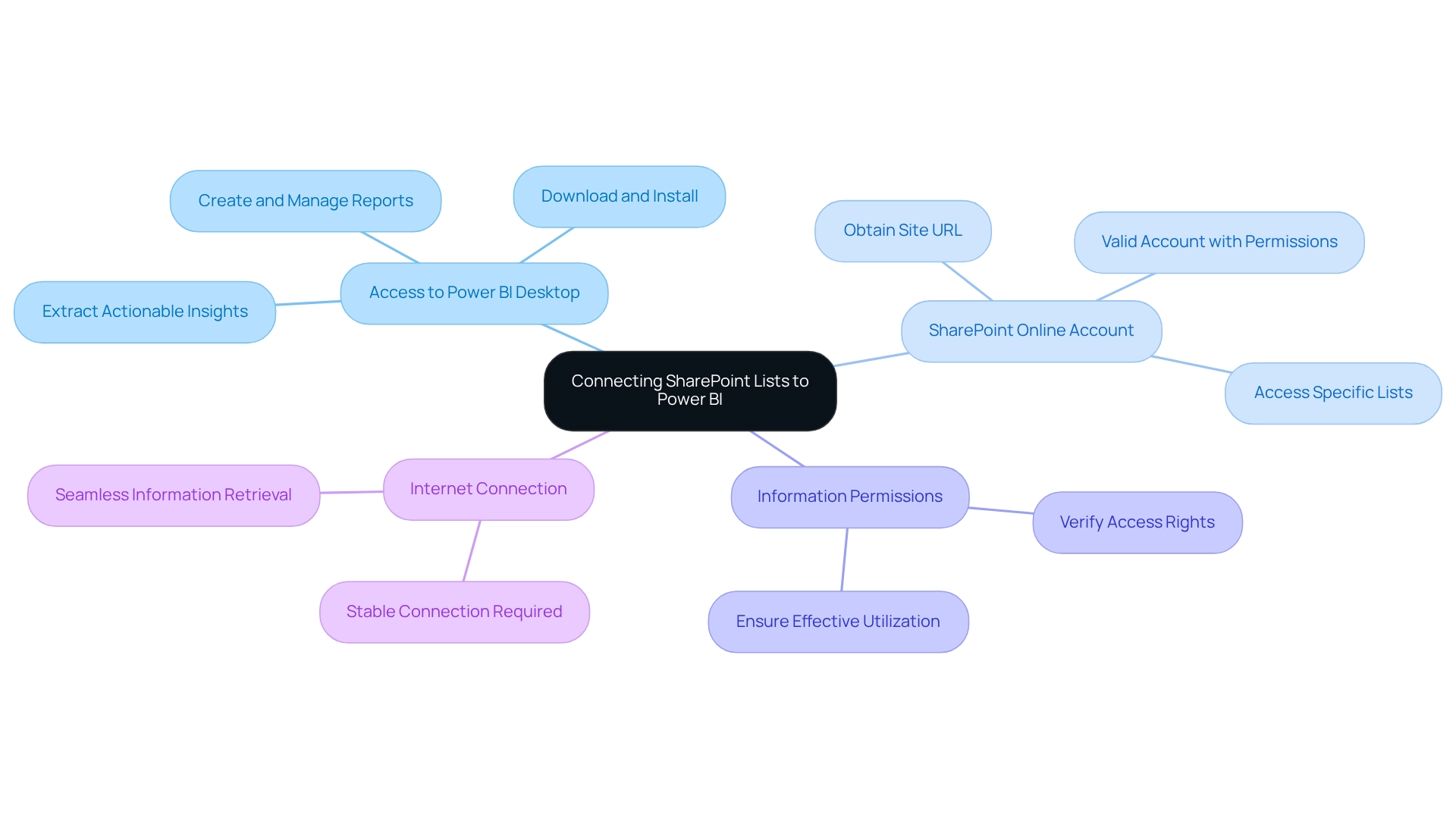
Step-by-Step Process to Connect SharePoint Lists to Power BI
To seamlessly connect your SharePoint list to Power BI and enhance operational efficiency through automation, follow these detailed steps:
- Open Power BI Desktop: Begin by launching the Power BI application on your computer.
- Get Data: Navigate to the ‘Home’ tab and select ‘Get Data’ to initiate the connection process.
- Select Online List: In the ‘Get Data’ window, choose ‘Online Services’ and then opt for ‘Online List’ to specify the data source.
- Enter Site URL: Input the URL of your collaboration site (e.g.,
https://yourcompany.sharepoint.com/sites/yoursite) and click ‘OK’ to proceed. - Authenticate: When prompted, sign in using your credentials to verify your access.
- Select Your List: A navigator window will appear displaying available lists. Select the particular SharePoint list to Power BI that you want to import and click ‘Load’ to bring the information into Power BI.
- Create Reports: With the information successfully loaded, you can now begin crafting reports and visualizations, leveraging the insights from your SharePoint list to Power BI.
This process not only enhances your analytical capabilities but also permits the creation of dynamic visualizations that can significantly improve understanding and insights derived from your information. By incorporating Robotic Process Automation (RPA) into your workflows, you can automate the repetitive tasks related to information management, thereby minimizing mistakes and allowing your team to focus on more strategic initiatives. Organizations that have effectively combined Power BI with other platforms have reported enhanced efficiency in information management and reporting, demonstrating the transformative potential of this integration.
As a best practice, ensure that you regularly review user permissions in the platform to maintain data security and integrity, as highlighted in recent case studies on configuring permissions for secure data use. Additionally, with the most popular content accessible in the platform over the last two weeks, it is crucial to leverage these insights for informed decision-making. As laurenlee, a frequent visitor, mentioned, “Thank you, I already have GA set up but we are unable to track demographic information with GA which is why we need to access proper stats in the platform.”
This highlights the importance of integrating robust data analysis tools to overcome common challenges.
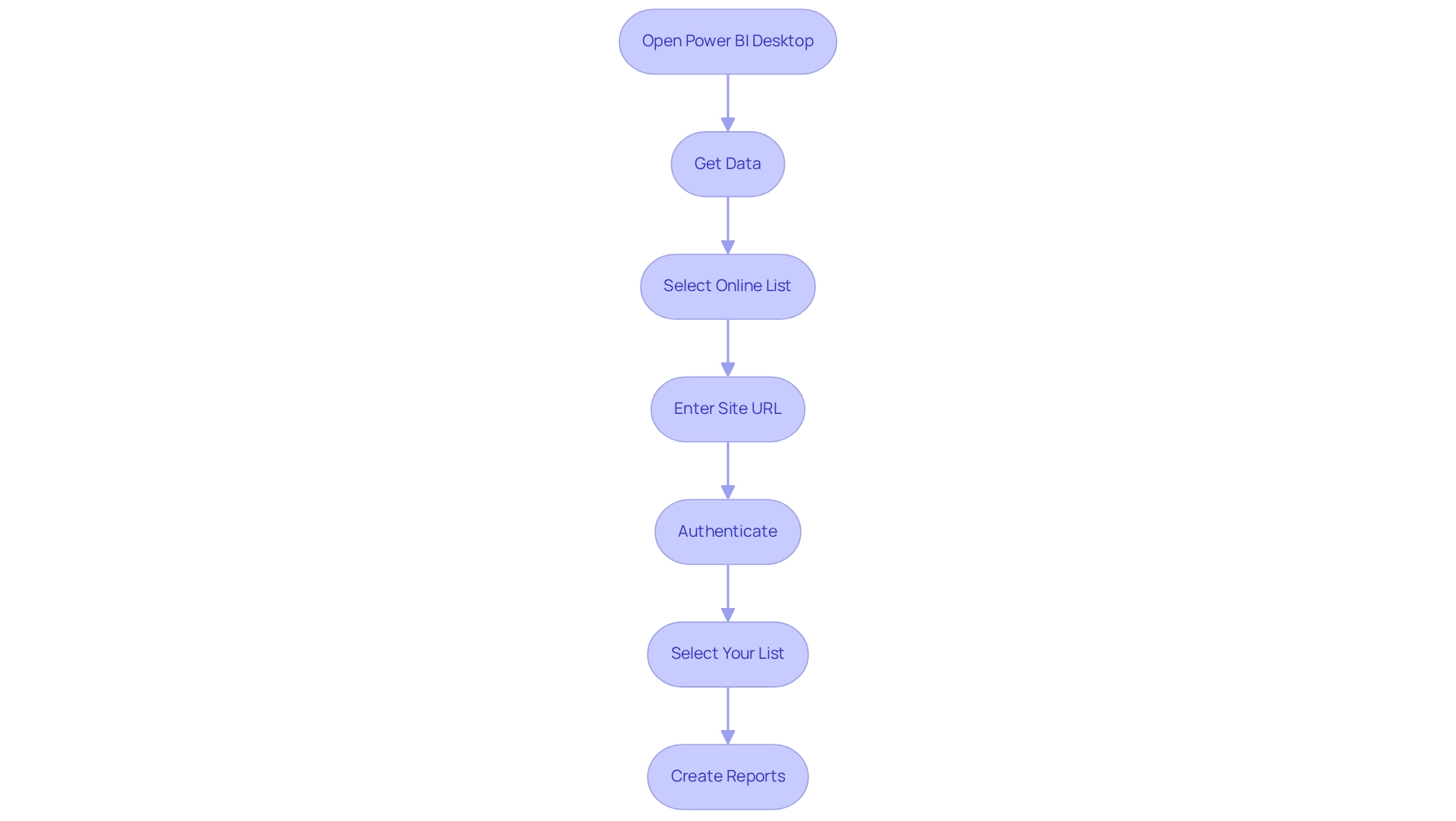
Troubleshooting Common Connection Issues
When linking a SharePoint list to Power BI, several challenges may arise that can hinder your efficiency and decision-making capabilities. Here are effective troubleshooting tips to help you navigate these obstacles:
- Check Permissions: Confirm that you have the necessary permissions to access the list. Inadequate permissions are a frequent barrier to successful connections and can lead to wasted time and resources.
- Verify URL: Ensure the site URL is accurate and free of subfolders. An incorrect URL can prevent Power BI from locating the data source, complicating your data integration efforts.
- Authentication Issues: Authentication errors are common, with many users reporting difficulties. Make sure you are using the correct credentials and that your account has the appropriate access rights to the site.
- Network Connectivity: A stable internet connection is crucial. Weak connectivity may lead to timeouts or unsuccessful connections, disrupting your workflow and impairing your ability to leverage Business Intelligence effectively.
- Clear Cache: Clearing the Power BI cache can often resolve persistent connection issues. Navigate to ‘File’ > ‘Options and settings’ > ‘Options’ > ‘Load’ to clear the cache and refresh your connection.
In a recent case study titled ‘Business Intelligence Empowerment,’ organizations that implemented these troubleshooting strategies reported significant improvements in their ability to connect a SharePoint list to Power BI. This enhancement led to better information quality and more informed decision-making. Notably, the CSV file contains 15 columns, underscoring the importance of understanding information structure when addressing connection issues. By tackling these common challenges, you can streamline your information integration process and fully harness the potential of your business intelligence tools, ultimately boosting your operational efficiency.
Additionally, consider how Robotic Process Automation (RPA) and tailored AI solutions from Creatum GmbH can further enhance your efficiency and decision-making capabilities.
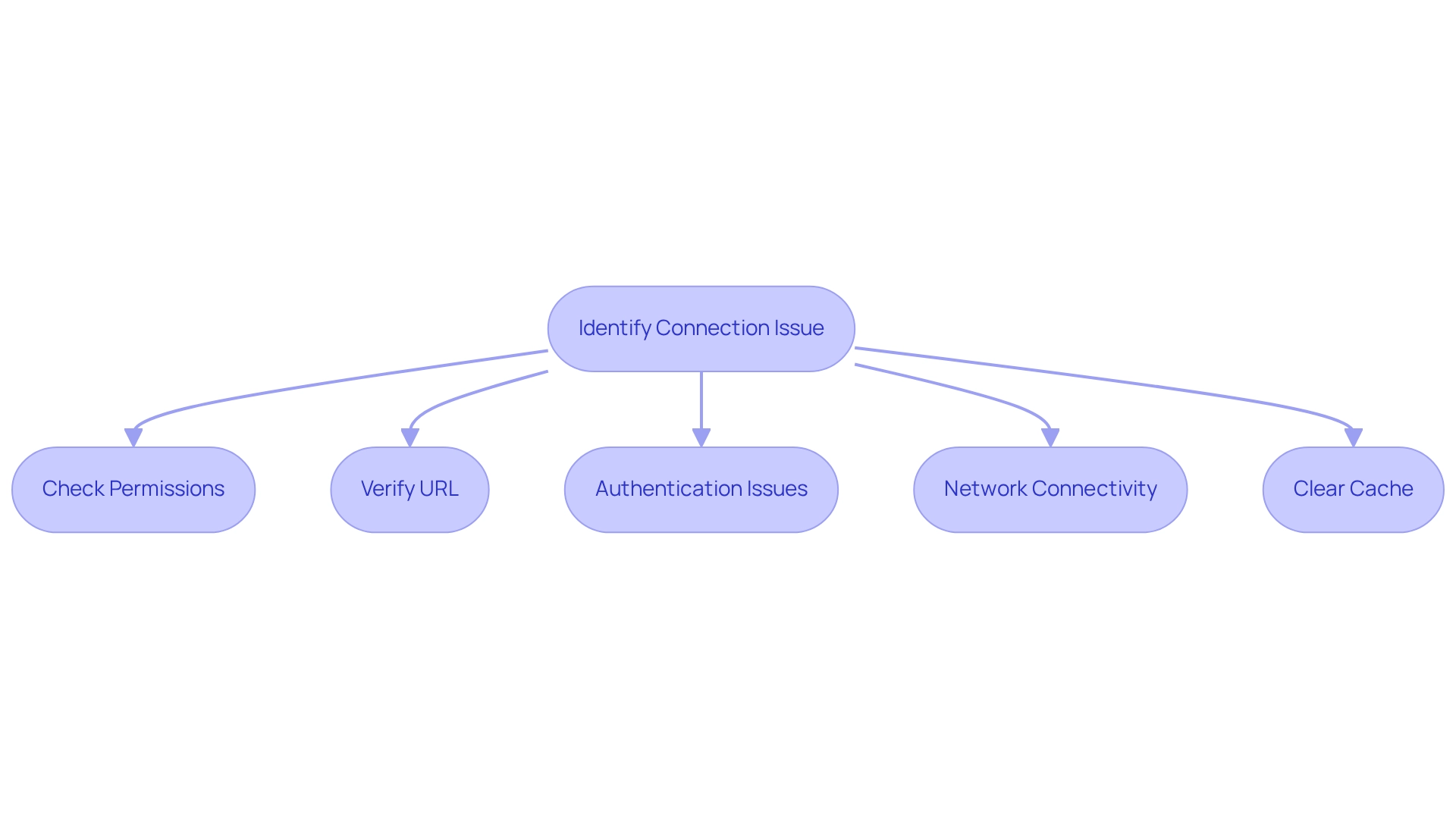
Advanced Features and Customization in Power BI and SharePoint Integration
After successfully linking SharePoint lists to BI, you can leverage several advanced features to enhance your reporting capabilities:
-
Custom Visuals: Elevate your reports by utilizing custom visuals available in BI. Importing visuals from the marketplace allows for captivating presentations tailored to your unique storytelling needs. Organizations that have embraced custom visuals report increased user engagement and improved information comprehension, which is vital for generating actionable insights.
-
Information Transformation: Power Query serves as a powerful tool for modifying your data before it enters Power BI. This includes essential tasks such as filtering, merging, and shaping your data to align with your reporting goals. Effective information transformation can significantly enhance the accuracy and relevance of your insights, with studies indicating that proper data preparation can lead to a 30% increase in reporting success rates. As noted by Yogesh Ajmire, there is a keen interest in acquiring comprehensive dataset information, including the volume of datasets and their most recent updates, underscoring the importance of efficient data management and governance in addressing inconsistencies.
-
Scheduled Update: To ensure your BI reports consistently reflect the latest information from the platform, implement scheduled updates. This feature can be easily configured within the BI service, facilitating real-time data updates that enhance decision-making processes and promote a data-driven culture within your organization.
-
Embedding Reports: Integrating BI reports directly into site pages provides seamless access and collaboration among team members. This integration not only streamlines workflows but also fosters a data-driven culture, enabling users to interact with live reports without leaving the SharePoint environment. However, it is crucial to acknowledge that usage metrics do not capture engagement for embedded dashboards and reports, which can impact how organizations assess their reporting strategies.
-
Training and Certification: For individuals aiming to enhance their expertise, training and certification resources are available for advanced techniques in Business Intelligence. This empowers users to fully leverage the platform’s capabilities, ultimately driving operational efficiency and growth.
-
3-Day BI Sprint: Creatum GmbH offers a 3-Day BI Sprint, enabling organizations to swiftly create professionally designed reports tailored to their specific needs.
-
General Management Application: The General Management Application delivers comprehensive management and smart reviews, further enhancing the reporting capabilities of BI.
By exploring these advanced features, including the 3-Day BI Sprint and General Management Application, and considering the limitations of usage metrics, you can significantly enhance the functionality of your BI reports, ensuring they deliver actionable insights that drive operational efficiency.
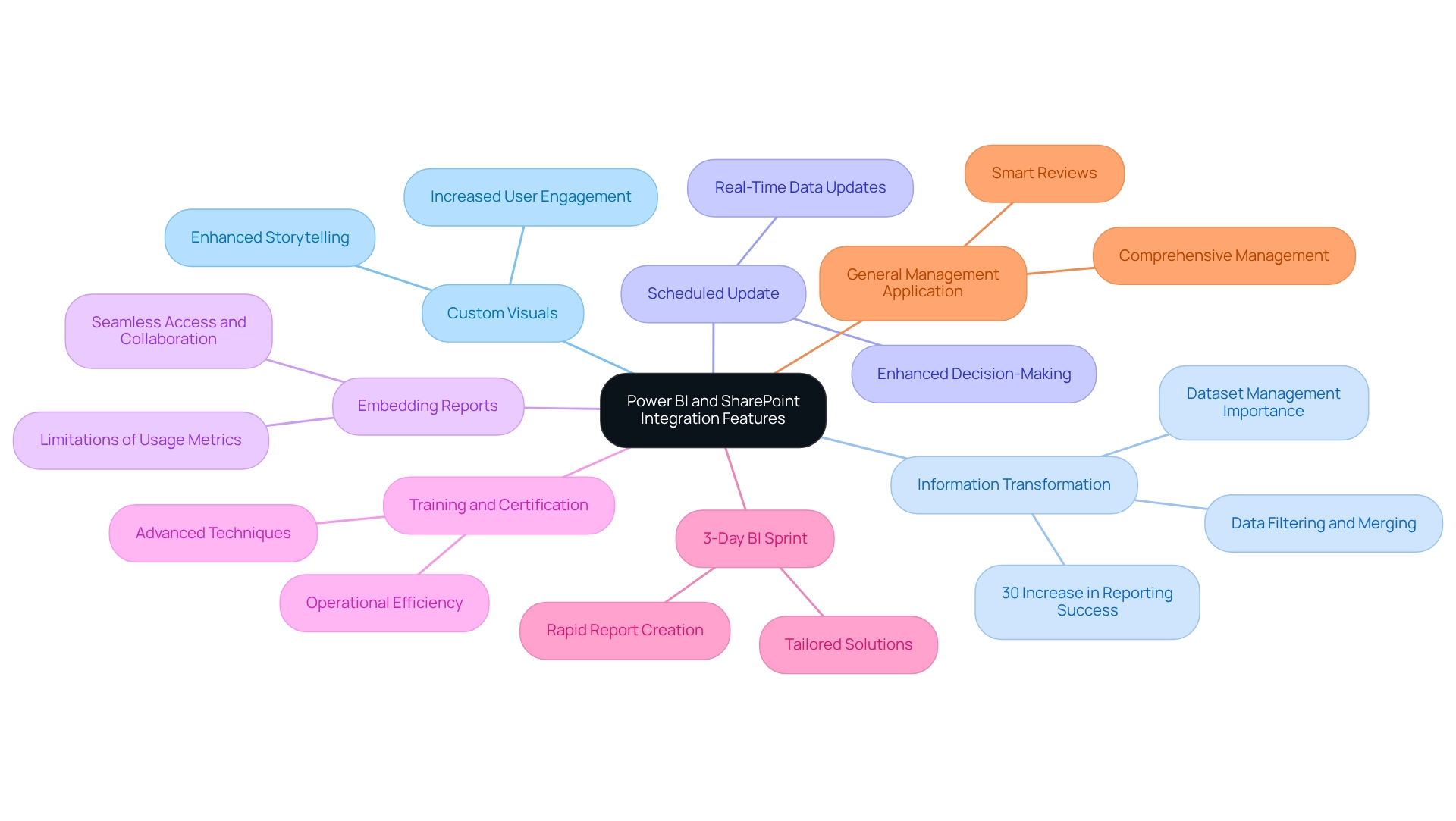
Best Practices for Data Security and Integrity
To ensure data security and integrity when integrating Power BI with SharePoint, organizations must adhere to the following best practices. These practices not only enhance security but also support operational efficiency and informed decision-making:
- Utilize Organizational Accounts: Always connect using organizational accounts to guarantee secure access to SharePoint data. This method reduces the threat of unapproved entry and conforms to industry guidelines for information protection, thus improving overall efficiency.
- Implement Role-Based Access Control (RBAC): Establish clear user roles and permissions within SharePoint to regulate who can view or modify information. Organizations using RBAC experience a considerable decrease in breaches, as it restricts entry to sensitive information based on user roles, promoting a secure setting for insight generation.
- Enable Multi-Factor Authentication (MFA): Strengthen security by requiring MFA for users accessing sensitive information. This extra layer of protection is essential in reducing risks linked to compromised credentials, particularly in settings where remote connectivity is common, guaranteeing that your information stays secure while enhancing operational efficiency.
- Regularly Review Permissions: Conduct periodic assessments and updates of user permissions to ensure that only authorized personnel can reach specific information. This practice not only improves security but also assists in upholding compliance with governance policies, which is crucial for utilizing insights from Power BI dashboards effectively.
- Monitor Information Retrieval: Utilize the auditing capabilities of the platform to monitor who retrieves information and when. This capability is crucial for detecting unauthorized access attempts and ensuring accountability among users, vital for upholding the integrity of your information.
- Stay Informed on Security Trends: Keep abreast of the latest security trends and recommendations from cybersecurity experts. For instance, Amichai Shulman emphasizes the significance of comprehending supply chain attacks in low-code/no-code development settings, pertinent to the integration of BI and SharePoint. Furthermore, specialists highlight the importance of proactive security measures, such as governance and loss prevention strategies, especially in light of rising cyber threats.
- Utilize BI’s Versatility: Remember that the BI application supports iOS, Android, and Windows devices, improving accessibility while ensuring security. This flexibility enables users to retrieve information securely from multiple platforms, facilitating prompt decision-making.
- Understand User Authentication: Familiarize yourself with the user authentication process in BI, which follows a sequence of requests and responses using Microsoft Entra auth code grant flow. This understanding is essential for guaranteeing secure entry to information and addressing challenges associated with inconsistencies in information.
- Employ Secure Mobile Access: The BI mobile application supports secure information storage and user verification, employing industry-standard security measures. This underscores the significance of security measures in the realm of mobile usage, ensuring that your team can operate effectively and safely.
By adopting these best practices, organizations can significantly improve the security of their integration from SharePoint list to Power BI. This protects sensitive information while allowing efficient entry for authorized users. The case study titled “Proactive Security Measures” demonstrates how organizations faced unparalleled access to systems by cybercriminals and suggested a mix of governance, multi-factor authentication, and loss prevention strategies to enhance security without compromising efficiency. Moreover, incorporating Robotic Process Automation (RPA) can further optimize processes and enhance operational efficiency, while customized AI solutions can help in addressing challenges connected to information extraction and report generation, ensuring that your organization remains competitive in an analytics-driven environment.
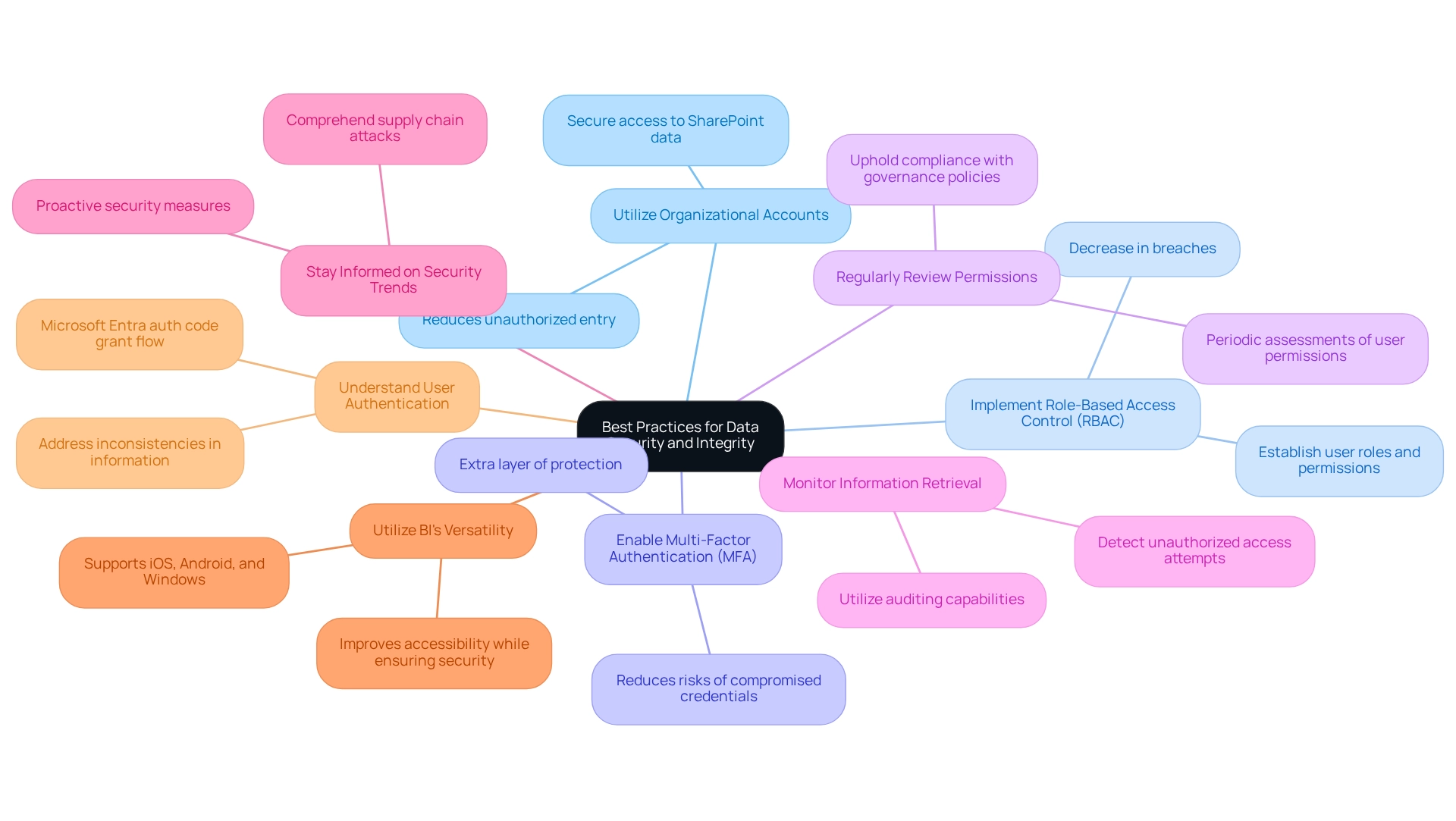
Benefits of Connecting SharePoint Lists to Power BI
Integrating SharePoint lists with Business Intelligence (BI) provides significant advantages that can enhance organizational efficiency and improve decision-making processes.
Improved Information Analysis: Users can generate comprehensive reports that delve deeper into their data, transforming raw information into actionable insights. This capability is essential in today’s data-centric environment, where informed decisions are critical. As highlighted by Sascha Rudloff from PALFINGER, the Power BI Sprint from Creatum not only delivered instant reporting capabilities but also accelerated their overall Power BI development, showcasing the transformative impact of such integrations.
Enhanced Decision-Making: Access to real-time information empowers organizations to make swift and informed choices. Statistics reveal that 56% of enterprises find real-time analytics beneficial for refining their decision-making processes, underscoring the importance of this integration. Furthermore, organizations with robust feedback mechanisms experience a 20% increase in user proficiency over time, emphasizing the necessity of continuous improvement in decision-making.
Streamlined Workflows: Automating information retrieval and reporting enables organizations to minimize manual effort, thereby enhancing productivity. This automation not only conserves time but also reduces the likelihood of human error, which is vital for maintaining information integrity. Harnessing Robotic Process Automation (RPA) from Creatum can further boost operational efficiency by mitigating errors and allowing teams to concentrate on strategic initiatives rather than repetitive tasks.
Collaboration: The integration cultivates a collaborative atmosphere where teams can effortlessly share insights and reports. This partnership enhances overall effectiveness and ensures that all stakeholders are aligned with the latest information derived from data.
Scalability: As organizations expand, the integration of Power BI supports the seamless growth of analytical capabilities. This adaptability ensures that existing workflows remain intact while accommodating increasing data demands.
A case study illustrating the establishment of permissions for secure information retrieval underscores the importance of implementing robust access controls within the platform. By adhering to the principle of least privilege and conducting regular audits of user permissions, organizations can significantly mitigate the risk of data breaches. This proactive strategy not only fortifies data protection but also leads to considerable cost savings, reinforcing the essential nature of secure data access in the context of integrating SharePoint lists with Power BI.
In conclusion, the integration of SharePoint lists with Power BI not only enhances data analysis and decision-making but also fosters collaboration and scalability, positioning it as a crucial strategy for organizations striving to excel in today’s data-driven landscape.
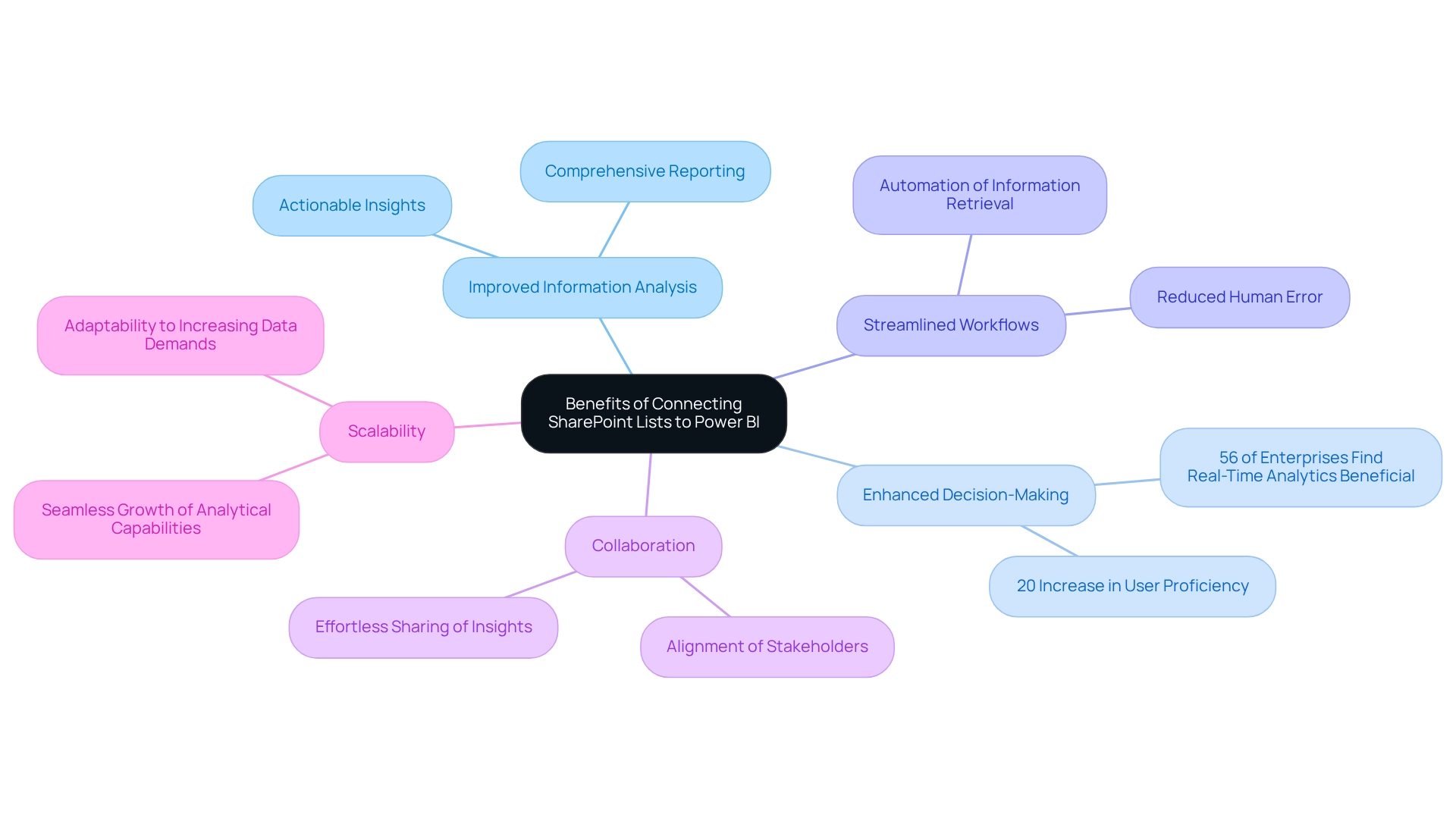
Conclusion
Harnessing the integration of Power BI and SharePoint unlocks a wealth of advantages that can transform organizational operations. By connecting SharePoint lists to Power BI, businesses enhance data visualization and accessibility, leading to improved decision-making and streamlined workflows. The seamless flow of real-time insights empowers teams to act swiftly in fast-paced environments, fostering a culture where data-driven decisions are the norm rather than the exception.
Moreover, this integration facilitates collaboration among teams, allowing for easy sharing of reports and insights directly within the SharePoint platform. This collaborative approach boosts productivity and ensures that all stakeholders remain aligned with the latest developments. As organizations grow, the scalability of this integration guarantees that data analysis capabilities can expand without disrupting existing workflows, thereby supporting ongoing operational efficiency.
In a landscape where the demand for actionable insights continues to rise, the effective use of tools like Power BI and SharePoint becomes vital. By adhering to best practices for data security and integrity, organizations protect sensitive information while reaping the benefits of enhanced data analysis and reporting capabilities. Ultimately, the strategic integration of these two powerful tools is not just about improving data access; it cultivates a robust data culture that drives innovation and growth in today’s competitive business environment.
Frequently Asked Questions
What is the primary function of the tool mentioned in the article?
The tool is a robust business analytics application that enables users to visualize information and share insights across their organizations.
How does the tool integrate with Microsoft Office?
The platform operates as a web-based collaboration tool that is seamlessly integrated with Microsoft Office, allowing for enhanced functionality.
What is the significance of integrating SharePoint lists with Power BI?
The integration significantly enhances information accessibility and fosters improved collaboration and decision-making processes within organizations.
What are the key benefits of the integration between SharePoint and Power BI?
Key benefits include enhanced information visualization, real-time insights for timely decision-making, and improved collaboration through report sharing.
What services does Creatum GmbH offer to support report creation?
Creatum GmbH offers services such as the innovative 3-Day Sprint and the General Management App, which streamline the report creation process and address information inconsistency and governance challenges.
What statistic highlights the need for effective information integration tools?
Recent statistics reveal that fewer than 20% of executives believe they have established a ‘culture of information’ within their organizations.
Why is accessible analytics important starting in 2024?
The need for accessible analytics solutions becomes pressing to enable non-technical users to extract insights from data.
What are the prerequisites for linking SharePoint lists to Power BI?
Prerequisites include access to Power BI Desktop, a valid SharePoint Online account with necessary permissions, appropriate information permissions, and a stable internet connection.
How can organizations enhance their information integration efforts?
Organizations can enhance their efforts by adhering to the prerequisites and regularly monitoring adoption to improve resource allocation and strengthen executive support for projects.
What challenges might organizations face when utilizing insights from BI dashboards?
Organizations may encounter challenges such as time-consuming report creation and data inconsistencies, which can hinder the full capitalization of the benefits of RPA and Business Intelligence.